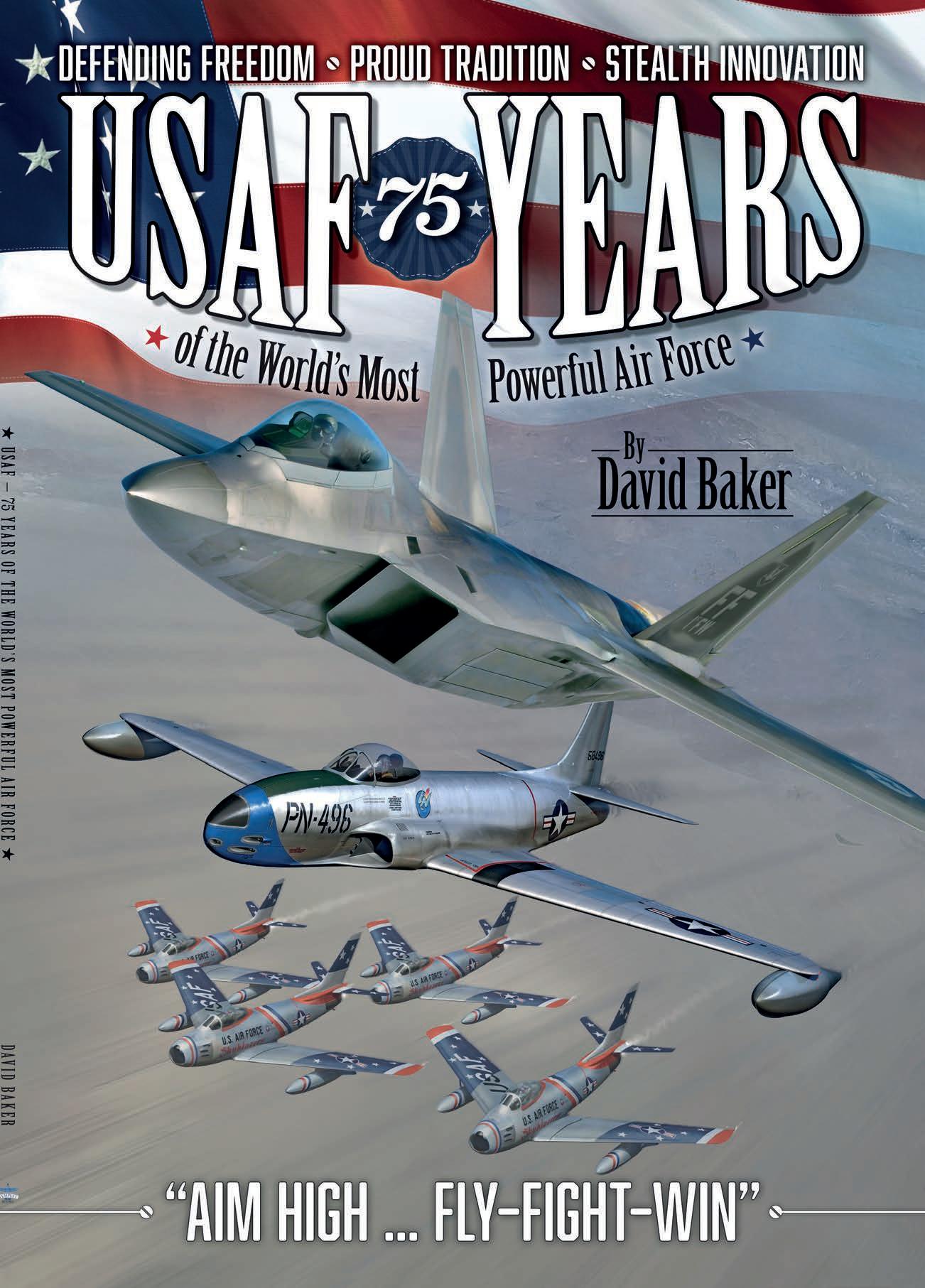
On December 7, 1941, the Imperial Japanese Navy launched a devastating surprise attack on the US naval base in Pearl Harbor, Hawaii, leaving 2403 Americans dead and more than 1000 wounded. Five ships and 188 aircraft were destroyed. The offensive stunned a nation that had - to this point - avoided being dragged into the Second World War. Within days, America had declared war on Japan and entered what was now a truly global conflict. More than a century of isolationism had been swept aside and the US was propelled into a conflict that would ultimately result in it becoming the international superpower and ‘policeman of the world’ that we know today.




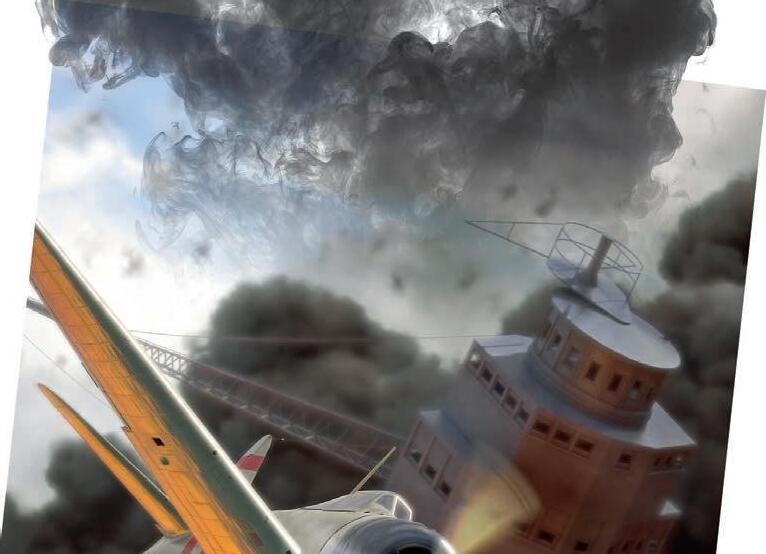
Released to coincide with the 80th anniversary of the attack, this 132-page volume looks in detail at how the events of December 7, 1941, unfolded at Pearl Harbor, the military forces involved from both sides and the key people who played a part. The story is told through hundreds of rarely seen photographs and combines eyewitness accounts with in-depth analysis of this critical turning point that changed world history forever.

£8.99


ON SALE NOW 132 page, full colour, perfect bound bookazine Visit: www.classicmagazines.co.uk/thebookshelf Call: 01507 529529 Also on sale in major UK newsagents, plus other stores
AT THEHEARTOFTHEUNITEDSTATESAIRFORCE AREITSPEOPLE.THEPILOTSANDAIRCREW,THE GROUNDTECHNICIANS,SERVICINGTECHNICIANS, LOGISTICALSUPPORTSTAFFANDALLTHESUNDRY JOBSREQUIREDTOOPERATETHEWORLD’S LARGESTGLOBALAIRPOWERCOMETOGETHER INPERFORMANCEAND ACONSTANTSTATEOF READINESS,EPITOMISEDHEREBYTHECREWOF ANF-15ESTRIKEEAGLEASVIEWEDFROMTHEAFT WINDOWOF AKC-135AREFUELING TANKER. USAF


006 Chapter 1
Uncertain Prelude
The Americans were the first to fly a piloted aeroplane, but very late in putting it into service for the military.
013 Chapter 2 War! 1917-1918
When President Woodrow Wilson sent the Army to Europe, America’s first military aviators went with them.
023 Chapter 3
Rebirth 1919-1935
New designs turned wooden planes into war machines of metal, for new wars on the horizon.
032 Chapter 4
A Global Force 1935 -1941
As Europe tipped toward conflict, the Army built new warplanes for the coming conflagration.
043 Chapter 5
A Taste of War 1941
Shocked by Japan’s violent adventures in China, America reeled under an attack at Pearl Harbor.
050 Chapter 6
Preparations 1941-1942
From an “arsenal of democracy”, American warplanes poured out the factory gates in unprecedented numbers.
059 Chapter 7
Crushing the Axis 1941-1943
With North Africa first, then Italy, American air power joined an escalating conflict in Europe.
069 Chapter 8
Combined Offensive 1942-1943
Teaming up with Britain’s Royal Air Force, the Army sent flyers to support a bombing campaign on Germany.
079 Chapter 9
Maximum Effort 1943-1944
Supporting an invasion of continental Europe the Army Air Forces bring crushing defeat to the Nazis.
087 Chapter 10
Supreme Endeavours
1944-1947
A strategic bombing campaign against Japan ends a war and creates an independent Air Force.
090 Chapter 11
Cold War Challenges
1948-1960
Soviet aggression and proxy wars bring clashes between the Air Force and communist jet fighters.
096 Chapter 12
Vietnam
A long and bloody war brings supreme challenges and an effort constrained by political meddling.
102 Chapter 13
Cold War Arms Race
The Air Force enters the age of strategic nuclear missiles, supersonic bombers and spy planes.
109 Chapter 14
Getting Stealthy
New technologies give US combat aircraft the edge in the war against the radar sites.
114 Chapter 15
Gulf War
The biggest air operation since the Second World War evicts an aggressive invader and frees an occupied country.
121 Chapter 16
21st Century Air Force
New challenges and a global peace-keeping role supplement humanitarian efforts and relief operations.
127 Chapter 17
Future Force
New generations of aircraft combine smart weapons, stealthy aircraft and the promise of hypersonic strike.

4 USAF: THE WORLD’S MOST POWERFUL AIR FORCE
Contents
AUTHOR: David Baker
DESIGN: atg-media.com / Burda Druck India Pvt. Ltd.


PUBLISHER: Steve O’Hara
PUBLISHING DIRECTOR: Dan Savage
REPROGRAPHICS: Jonathan Schofield and Paul Fincham
PRODUCTION EDITOR: Dan Sharp
ADVERTISING MANAGER: Sue Keily, skeily@mortons.co.uk
MARKETING MANAGER: Charlotte Park
COMMERCIAL DIRECTOR: Nigel Hole
PUBLISHED BY: Mortons Media Group Ltd, Media Centre, Morton Way, Hor ncastle, Lincolnshire LN9 6JR. Tel: 01507 529529
ACKNOWLEDGEMENTS: The author would like to thank the United States Air Force for help and assistance over 55 years of a close working cooperation in research and associated activities in many locations around the world, the sum total of which has formed the basis for some of the material used in this publication. Secondarily, the assistance of the US Department of Defense over a similar period has contributed greatly to gathering historical material which has also contributed to the information on these pages. In particular to Bettie Sprigg at the Pentagon so many years ago and who opened so many doors.


Thanks are also due to Steve O’Hara at Mortons for having published this book, suffering the vagaries of the author along the way
PRINTED BY: William Gibbons and Sons, Wolverhampton
ISBN: 978-1-911639-02-2
© 2022 Mortons Media Group Ltd. All rights reserved. No part of this publication may be reproduced or transmitted in any form or by any means, electronic or mechanical, including photocopying, recording, or any information storage retrieval system without prior permission in writing from the publisher
5 USAF: THE WORLD ’S MOST POWERFUL AIR FORCE
UncertainPrelude
ThecallforAmericanstotaketotheskies overfuturebattlefieldscamein1783when BenjaminFranklinobserved ahot-air balloonascendingoverthe rooftopsofParis. Impressedbytheirfree-floatingdisregardfor boundariesandborders,heforesawinvading armiesusingballoonstocrosslanddominated byenemiestoplacetroopsatthe rearof combatunits.
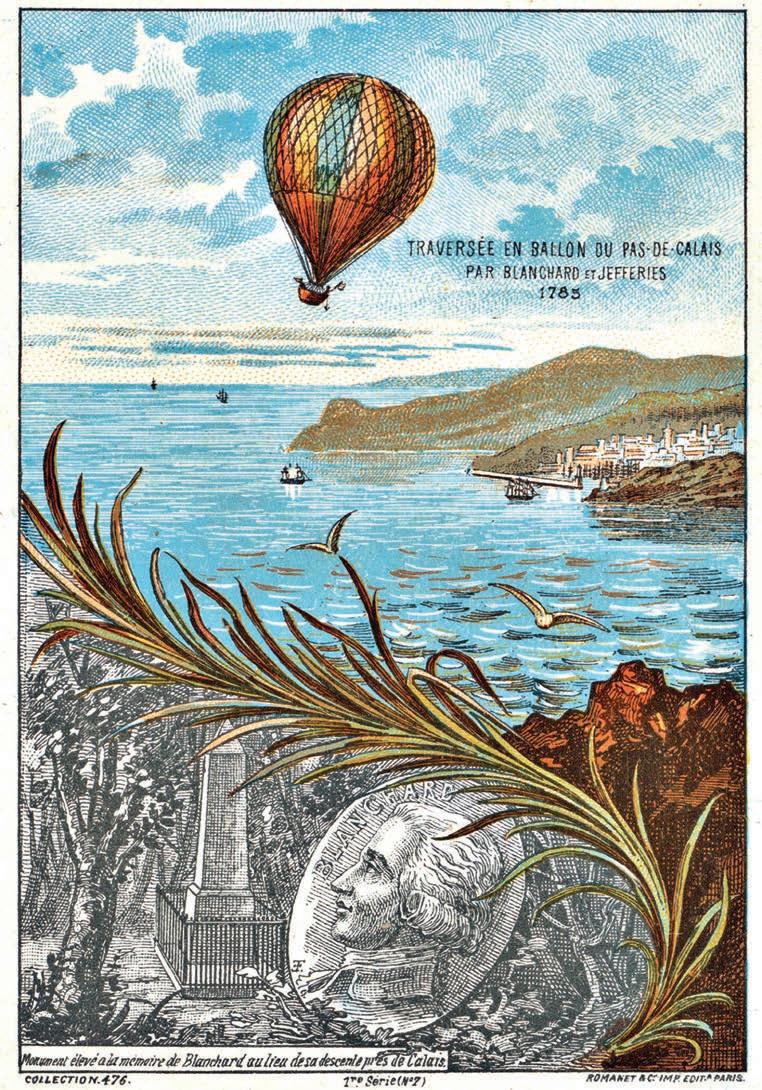
ThatcapabilityachievedplausibilitywhenJeanPierreBlanchardcrossedtheEnglishChannelina balloonlessthantwoyearslater.
TheFrenchconcurredwithFranklinandsetupthe world’sfirstmilitaryairunit –theAerostaticCorps –in1794butNapoleondisregardedtheballoon asanobservationpost,disbandedtheCorpsand somesay,lostthebattleof Waterlooas aresult.
Ayearearlier,in1793Blanchardhadtaken hisballoontotheUnitedStatesfromwherehe madethefirstascentfromNorthAmericansoil watchedbyGeorge Washington,whodisagreed withNapoleonandencourageddevelopment oftheunpredictabledevices.ButtheArmy apparentlysidedwithNapoleonandthought
them afrivolousdistraction,avoiding requestsfor theiruseduringthewarwiththeSeminoleIndians in1840andagainsttheMexicansat VeraCruz in1846.Just15yearslatertheycameintotheir ownwhenhydrogenballoonsweredeployed firstbytheNorthintheAmericanCivil War, and thenbytheSouth,from1861.Butitwasa short-lived romancewithlighter-than-airflight; bythefollowingyearbothsides regardedthem assuperfluous.
In1892BrigadierGeneralAdolphus W. Greely, ChiefSignalOfficer,setup aballoonsection andshippedonetoCubaforthewaragainst theSpanish.Operatingfromthe regionaround Santiago,itdirectedartilleryfireatthefamous BattleofSanJuanHill.Thiscametoaninglorious haltwhenbulletsriddledtheenvelopeand broughtitdownneartoenemylines.

Butthepotentialforballoonshadbeen emphaticallysetdownwhenbesiegedParisian dignitariesduringtheFranco-Prussianwarof 1870-71sought ameansofevacuationacross encirclingenemylinesbymakinggoodtheir escapebyair.Unfortunatelytheplanwentaskew whentheprevailingwindsliftedthemuponlyto depositthemintheranksofenemytroopslaying siegetothecapital!
Undauntedbysuchembarrassingepisodes, theBritishtookballoontroopstoAfricaduring thecampaignintheSudanduring1885where theywereusedatMafekingamongotherplaces. Theysubsequentlyplayed amajor roleinthe Boer Warwheretheywerehandledandexploited withmilitaryprecisionandgreatsuccess, enablingdrawingsofenemypositionssentto thegroundinmessagebagsslidingdownthe retainingcable.Itwasall abitHeathRobinson butitworkedandtheArmyquicklygained respectforits‘balloonatics’.
Wavesofchangewereontheway,however. Whatwas really requiredwas alighter-than-air craftcapableofliberatedflightbutin acontrolled direction.Thatbecamepossiblewiththeadvent oftheairshipduringthe1890s,placingpropellers poweredby reciprocatingenginesongas envelopesanddirectingthemthroughtheairat willusingruddersandelevators.Mostnotable werethedirigiblesofCountvonZeppelinandthe BrazilianAlbertoSantosDumontshortlyafterthe dawnof anewcentury.TheBrazilianwouldbe thefirsttomakesignificantcontributionstoboth lighter-than-airandheavier-then-airflightbutnot beforetwoAmericanshadbecomethefirstto take aflyingmachineintotheair.
Inspiredbythelogicofscientificprinciples, WilburandOrville Wrighthadthoughtthrough theengineeringnecessarytouse alightweight reciprocatingenginetoprovidetheforward motionandacceleratethepassageofairacrossa liftingsurface.Thatwould,inturnallowanaircraft toascendfromthegroundandflyatwill,devoid ofthecomplexityof alargegasbag.Theybuilt their WrightFlyerNo. 1andpowereditintotheair forthefirsttimeonDecember17,1903.


Butthebrothersweredifficulttoworkwith, reclusiveandsuspiciousthatthesecretsoftheir aeroplanewouldbestolenbycompetitors.Infact themajorityofAmericanswouldnotdiscoverthis
 ABOVE: One of the most notable early balloonists was Pierre Henri Blanchard who made his first ascent in a hydrogen balloon from Paris in March 1784, heralding a new age of flight and a potential military use of the new science of aeronautics. DAVID BAKER
ABOVE: One of the most notable early balloonists was Pierre Henri Blanchard who made his first ascent in a hydrogen balloon from Paris in March 1784, heralding a new age of flight and a potential military use of the new science of aeronautics. DAVID BAKER
CHAPTER 1– 1907-1917
6 USAF:THE WORLD’S MOST POWERFUL AIR FORCE
ABOVE: The world’s first ‘aircraft carrier’, the George Washington ParkeCustis was acquired by the Union Navy during the Civil War of 1861-65 as a platform from which to spy on Confederate forces. US ARMY
world-changingfeat,whichhadbeenachieved byAmericansonUSsoil,untilseveralyearslater. Atthetimeofhisgraduationfrom WestPointin 1907,HenryH.Arnold,thefuturecommander ofUSArmyAirForceshadnoknowledgethat aircraftexisted. Twoyearsearlierthe Wrightshad offeredtheFlyertotheArmyBoardofOrdnance ofFortificationwhichallbutquestionedthevery existenceofanaeroplane.
Withjustifiable reason,fortheUSgovernment andtheinformedcitizenrywerescepticalabout poweredheavier-than-airflightaftertheexploits ofSamuelPierpontLangley,anastronomerand inventorwhobuiltmodelsofflyingmachines. Langleysentthemsuccessfullydownthe PotomacRiverat aheightof80ft,powered by aflashboilerusingsteam.Butattemptsto get amanintheairwithbiggeraircraftwere unsuccessful,despitegettingtheattentionof theUSNavywhosetup aboardtostudythe conceptusingfundsappropriatedbythe War Department.Ontwoattempts,attheendof1903 andinearly1904,theLangleycontraptiongot
DAVID BAKER
fouledbyitslaunchcatapultandcollapsedinto theriver.
By1905the Wrightshad respondedto overturesfromtheBritishtobuy Wrightflying machinesbyofferingthedesigntotheUSArmy, soastokeeptheinventioninAmerica,they said.Butwhenaskedbythe Wrightstopresent their requirements,theBoardofOrdnanceand Fortification refusedtoissue aspecification. Bytheendoftheyearthe Wrightshadbeen approachedbytheFrenchtooandonhearing abouttheoverseasinterestarousedbythe Wright Flyer,PresidentTheodoreRooseveltintervened. Hehadalreadyheardabouttheinventionfrom theAeroClubofAmerica,fromwhencethings movedquickly.
OnAugust1,1907,theSignalCorpssetup itsAeronauticalDivisiontogovern“allmatters pertainingtomilitaryballooning,airmachines







ABOVE: US troops inflating the balloon Intrepid in 1862 during the American Civil War. Aerialreconnaissance and gun laying was a new use for balloons and served to demonstrate the many ways in which both they and aeroplanes would be valuable for future military applications.

 DAVID BAKER
DAVID BAKER
LEFT: Blanchard signalled the end of England’s isolation from the European continent when he became the first person to cross the English Channelin a balloon in 1785, making his first balloon flight in America in 1793
 DAVID BAKER
DAVID BAKER
andallkindredsubjects”withCaptainCharlesde F. Chandlerinchargetogetherwithtwoenlisted men.Theyweretoexaminetheadvancing scienceof‘aeronautics’aswellasradiotelephonyforcommunicationstoandfromthe ground.Finally,inDecember,andin responseto PresidentRoosevelt’sdirective,Secretaryof War WilliamH. Taft requestedbidsfor aflyingmachine capableofcarryingtwopeopleat40mphfor125 miles.Onlythe Wrightbrothers respondedby producinganaeroplane.
Suddenly,almostovernightitseemed, theArmywastalkingaboutaviation.The industrialists,businessmenandsportsmenwho populatedtheAeroClub,foundedin1905to promoteallformsofflying,encourageddebate abouttheusesofflyingmachines.OneCaptain William‘Billy’Mitchelllecturedontheusesof aeroplanesfor reconnaissanceandfordropping
 ABOVE:In the Franco-Prussian war of 1870-71, Parisians besieged by Prussian forces sought a way of escape by taking to balloons, most of which came down in the ranks of the encircling army with some being swept out to sea!
ABOVE:In the Franco-Prussian war of 1870-71, Parisians besieged by Prussian forces sought a way of escape by taking to balloons, most of which came down in the ranks of the encircling army with some being swept out to sea!
7
USAF: THE WORLD’S MOST POWERFUL AIR FORCE
bombs.Aspartofhisexaminationandportfolio ofsubmissionsfortherankofcaptain,Mitchell hadstudiedaeronauticaltheoryatFortMyer, greatlyinfluencedbytheenthusiasmforsuch applicationsfromGeneralGreely.
Despitethegrowinginterestinheavier-thanairmachines,therewasstilldiscussionabout thehigherweight-liftingcapabilitiesofairships andtheArmydecidedtooffer$25,000fora winningdirigible.Seekingbackingforhisairship, ThomasBaldwinofferedtosellhisdesignfora mere$6750,hopingtosecuresalesand recoup hismoneyonvolumedeliveries.Hisairship wasacceptedandmadesomeimpressive appearancesthroughout1908.
Butitwasthe WrightBrotherswhobenefitted mostfromthisnewinterestinflying,which wouldsoongatherpopularsupportas


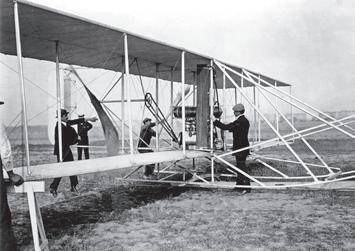
Americancitizensgot aglimpse,forthefirsttime, ofwhataircraft reallywereandhowtheycould perform.Rejected ayearbeforeanddismissed byArmytraditionalists,theorderfor aWright flyingmachine,thefirstgovernmentcontract foranAmericanaeroplane,wasplacedon February10,1908.


THEWRIGHTSTUFF
WilburandOrville Wrighthadmadeconsiderable progresssincemakingtheirfirstflightin December1903,theirimproveddesigns retaining thetriedandtestedpusherlayoutwithchaindrivebetweentheengineandthepropellersset across abiplaneconfigurationwith aforeplane stabiliserinfrontandtwinverticalruddersaft.

ThemachinetheybroughttoFortMyer,Virginia (namedafterthemanwhodisbandedtheballoon sectionaftertheCivil War!),acrossthePotomac from WashingtonforinitialtrialsonAugust20, 1908,had awingspanof40ft.Itwasslightly modifiedoverthe Wrights’standardA-model airframepoweredby afour-cylinder Wrightengine of25hpsetonthelowerwingtotherightofthe centreline.Thepilotsatinthecentre,withthe passengertohisrightoncushionedseatsnext totheengine.Thecylindricalfueltankwasabove thelowerwingtotheleftoftheenginewitha thinnarrow,verticalradiatorsettofillthespace betweenupperandlowerwings.
SkidswereprovidedtosatisfyanArmy requirementfortheaircrafttobecapableofflying from roughgroundbutthemethodofgettingit



intotheairwasstillbycatapultalong aprepared rail, aheavyfallingweightpulling arunningcable tolaunchtheaircraft.In afavourableheadwind itcouldgetintotheairunderitsownpower, however.Onceintheair,thepilotusedlevers tohislefttocontroltheaircraft.Forwardsand backwardsmovementsoperatedtheelevatorfor pitchcontrolandthewingswerewarpedtogo leftorright.
Thefirstflightdemonstrationtookplaceon September 2andoverthefollowingtwoweeks variousflightswereconductedincludingsome with apassenger.Onwhatwassupposedto bethefinalpreliminarydemonstrationflighton September17,1908,Orville Wrighttooktothe aircarryingLtThomasEtholenSelfridge.The propellercracked,snagged aflyingwireandthe aircraftcrashedtothegroundfrom aheightof 125ft.Orvillewasseverelyinjured,butsurvived, whileSelfridgedied afewhourslater,thefirst casualtytoflying.Onimpacthisheadhit astrut, fracturinghisskull.Fromthenon,Armypilots woreheadprotection.
IthadfallentoLtSelfridgetobethefirst USArmyofficertoflysolo,whenhehadflown the WhiteWing,designedandputtogether byAlexanderGrahamBell’sAerialExperiment Association(AEA).SponsoredbyBaldwin, White
ABOVE: Orville Wright prepares to demonstrate the vicissitudes of the Wright A flying machine as the reclusive Wright brothers seek a contract with the US Army. US ARMY
ABOVE: Samuel Pierpont Langley made heroic attempts to propel a powered flying machine into the air but failed, his name immortalised in one of the first aeronauticallaboratories in America. NACA
ABOVE: The world’s first heavier than air powered flight took place at Kill DevilHills,North Carolina, on December 17, 1903, when Orville Wright flew a distance of 120ft in 12 seconds at an average speed of 6.8mph in a freezing wind gusting to 27mph. NACA
8 USAF:THE WORLD’S MOST POWERFUL AIR FORCE CHAPTER 1– 1907-1917
LEFT: The Wright A Flyer at Fort Myer near Washington, DC, on September 9, 1908, where the Army Signal Corps would make its first purchase of a powered flying machine. US ARMY
WrightB ★
AdevelopmentoftheWrightFlyerwhich couldtraceitsorigintotheaircraftin which WilburandOrvilleWrightfirstflew, theWright Bwaspurchased by theUS governmentand attachedtotheAeronautical DivisionoftheSignalCorpin1911.The aircraft wasalso built by Burgessunder licenseand amodifiedversionbecamethe firstaircrafttocrosstheUnitedStates. The flightbeganonSeptember17,1911,from Brooklyn,NewYork,andended at LongBeach onDecember10after atotalflyingtimeof 84hours.AnotherversionoftheWright Bwas builtunderlicence by CurtissastheModel F.

LENGTH .2 6ft
WINGSPAN .3 9ft
HEIGHT 8.75ft
GROSSWEIGHT 1250lb
MAXIMUMSPEED 45mph
CRUISINGSPEED ..............4 0mph
RANGE 110miles
Wing wasthesecondaircraftdevelopedbythe AEAwithconsiderablecontributions,including engine,fromGlennCurtiss,whowouldvery quicklyachievefameforhisprogressiveaircraft designs.Selfridgehadbeenassignedbythe governmenttoworkwiththeAEAandhelped design RedWing,theAEA’s firstaeroplane,which
flewforthefirsttimeonMarch12,1908,butwas destroyedonitssecondflight.
AnimprovedaircraftwasbroughttoFortMyer inJune1909withobserversassignedbythe Armyto recordandtoevaluateitsperformance. OnJuly27,Orville Wrightkepthismachineand hispassenger,LtFrankLatham,aloftforone hour,12minutesand40seconds,achieving arecordintheprocess.Threedayslateran ebullientcrowdof7000spectatorsatAlexandria, Virginia,watchedPresident TaftwelcomeOrville WrightandLtBenjaminD.Foulois,backfrom a10-milecross-countryflightatanaverage speedof42.5mph.Thisachievementgavethe Wrights abonusof$5000ontopofthe$25,000 contractprice.
TheArmyformallyacceptedthe WrightModel AonAugust2,1909,withthehistoricnumber'1' inthelistofaircraftserialsthatbegan asequence whichtodayrunsintotheseveralhundred thousand.AeroplaneNo 1wasusedextensively andby1911wasinseriouslypoorcondition throughmanylandingaccidentsand repair cycles.Itwasfinally retiredonMay4,1911,butis nowinthecustodyoftheSmithsonianInstitution in Washington,DC.


Militaryaircraftserialnumbersran consecutivelyuntil acomplete revisionof thesystemin1921whichawardednumbers containedwithinthefinancialyearofthecontract award.Startingeachfiscalyearat 1andrunning toconclusionattheendofthatfiscalyear,itwas prefixedwiththelasttwodigitsofthefinancial
year.Thehighestnumber reachedbythedate oftransition(June30,1921)atthestartoffiscal year1922,was68,592,theaccumulatednumber ofaircraftorderedbytheArmytothatdate.The systemexiststothepresentday.


Partofthecontractawardedtothe Wrights wasthattheyshouldtraintwoArmyofficersto bepilotsandinOctober1909Wilburtrained LieutenantsLahmandFrederickE.Humphreys at afieldadjacenttoCollegePark,Maryland. Bothmensoloedandwithonlythreehoursflying timeapiecewereofficiallyinductedasthefirst ArmypilotsonOctober26.BecauseanArmy regulation restrictedtheamountoftimeanofficer couldbecalledto‘specialduties’,Lahm returned tohiscavalryunitandHumphreys rejoined theEngineers,leavingtheArmywithoutpilots. Neitherdidithave aserviceableaeroplane,No 1havingbeendamagedin acrashlandingon November5.
WhileNo 1wasin repair,becausethewood, canvasandwire-bracedaeroplanesoftheday wereunsuitableforthewintryweatherofDC,the ArmymovedoperationstoFortSamHouston, Texas,and receivedNo 1inFebruary1910.The onlycandidateforpilotdutywasLtFoulois. OnMarch 2hetooktotheairtoteachhimself tofly,ofnecessityeachascentbeing asoloon instructionsbyletterfromthe Wrights!Eventually someonefromthe Wrightsturneduptogive practicaladviceandFouloismade61flights betweenMarchandSeptemberbutstilltheArmy hadonlyonepilotandoneaeroplane.
RIGHT: American publishing magnate William Randolph Hearst offered a $50,000 prize to the first man to fly across the US coast-to-coast. The most flamboyant flight attempt was made by Calbraith Perry Rogers who named his Wright EX after a sponsor, the manufacturer of the grape drink VinFiz. DAVID BAKER
9
MOST POWERFUL AIR FORCE
BELOW: A contrast of flying devices as the Wright ‘Military Flyer’is moved at Fort Myer alongside a gas balloon used forreconnaissance US ARMY
USAF: THE WORLD’S
WhenAeroplaneNo 1was retiredinMay1911 anddelivereduptotheSmithsonianinOctober itwentinparallelwiththefirstfundingawarded byCongressforArmyaviation,theSignalCorps havingpreviouslyawardedcontractsfromits experimentalfundandfrom readjustingpayments fromothersectors.During1910,FortSam Houstonhad ameagre$150forfuel,oiland repairs,whileFouloishadfundedhimselfthrough pilot‘training’.ThatallchangedonMarch13, 1911,whenCongressappropriated$125,000, whereuponChiefSignalOfficerJamesAllen orderedfivenewaircraftatabout$5000apiece. InApril aWright Band asingle-seatCurtiss Model Darrivedwith a60hpengine,thelatter beingArmyAeroplaneNo.2.
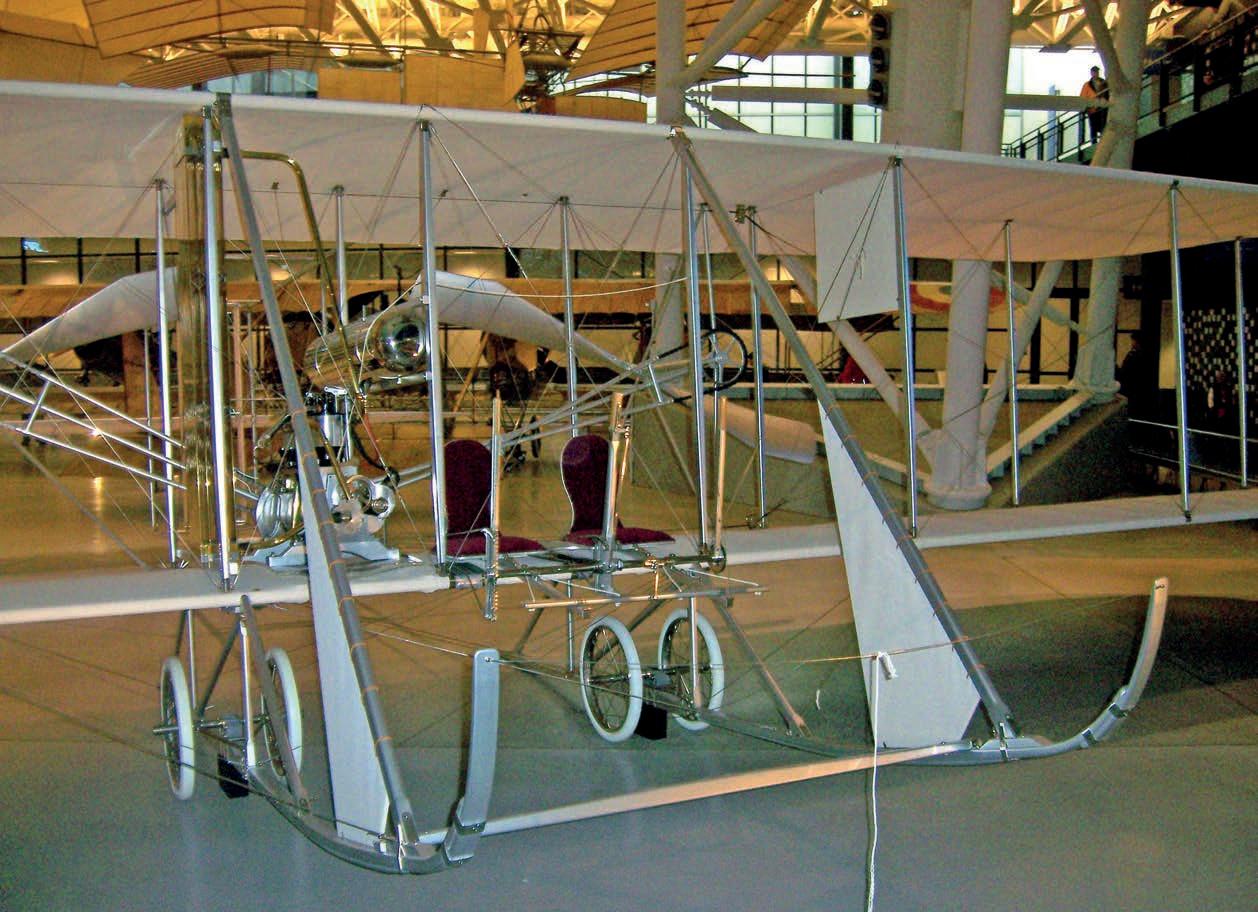
After abriefperiodawayfromheadingupthe AeronauticalDivision,CaptainChandler resumed hispositioninJune1911andpresidedoveran expansionoftheinventoryandthefacilities.Long
durationflightsof42mileswereaccomplished, achievingaltitudesofmorethan4000ftand investigationsbeganintotheuseofaerial photographyandnewbombsights,thelatter developedbyRileyE.Scott.ButwhentheArmy hadnomoneytodevelopitfurther,Scotttookhis inventiontoEuropeand returnedricherby$5000. To avoidthewinterweather,activitiesmovedto Augusta,Georgia, returningtoCollegeParkin April1912.
Duringtheyear afurtherdozenpilotswere trainedupandvisitsweremadetomanufacturing plantsforshopandflyingcourses,theirtraining nowexpandingtothemechanicsofflightandthe moresophisticatednuancesofflying.InAugust 1912FouloistooktwoaeroplanestoConnecticut todeterminetheadvantagesof reconnaissance from aprescribedaltitudeof2000ftduring exercises.BytheendoftheyearCollegePark had14flyingofficers,39enlistedmenandnine
COMMANDERS 1914-1917
aeroplanes,includingonehydroplanefromthe BurgessCompany,thefirsttractorbiplanebought bytheArmy.
Forwinterthe Wrightaeroplaneswentto GeorgiawhiletheCurtissmachinesweretaken toSanDiego,California,whereGlennCurtiss had afacility.ThiswouldbecometheArmy’sfirst permanentaviationschool.InFebruary1913 thegroupatAugustawereorderedsouthtojoin the2ndArmyDivisionin TexasCitywherethey preparedtosupportmilitaryoperationsagainst General VictorianoHuerta,whohadseizedpower inMexicoonFebruary23.Whilehewasthere, Chandlerorganisedhismenintothe1stAero Squadronwhichbegantheformal recognitionof anactivemilitaryaviationunit.
ASTRUGGLEFOR INDEPENDENCE



ThecrisisinMexiconeverdiddevelopinto awar withtheUSbutconsiderabletimewasspentin theairexploringhowflyingcouldbestassistan armyinthefield.Therewasdeepdissatisfaction amongtheaviatorshowever,whowerebecoming increasinglyfrustratedbywhattheysawasthe heavy-handedleadershipofground-huggingstaff officersatthetopin Washington –oblivioustothe uniquenatureofthisnewadjuncttotheSignal Corps.Theaviatorsbecamevocal,writingwith theircomplaintstoseniormilitaryfiguresinthe

Aug1,1907
July1,1910
June20,1911
September10,1913
July18,1914 –May 5,1916 •LieutenantColonelGeorgeO.Squier May6,1916 –February19,1917
ABOVE: A progressive development of the early Wright aeroplanes, the Wright B, seen here as a replica at the National Air and Space Museum, Washington, DC,incorporated a wheeled undercarriage and modified controls, a considerable improvement on the Wright A. DAVID BAKER •CaptainCharlesdeForestChandler
–June30,1910 •CaptainArthur S. Cowan
–June19,1911 •CaptainCharlesdeForestChandler
–September9,1914 •MajorSamuelReber
–July17,1914 •LieutenantColonelSamuelReber
CHAPTER 1– 1907-1917
10 USAF:THE WORLD’S MOST POWERFUL AIR FORCE
nation’scapital.Theseedsofautonomyhadbeen sownandwereenshrinedwithinthoseletters, whichhadthedesiredeffectandbegan aprocess ofchangethatwouldtake34yearstocomplete.
By1913theSanDiegoschool,fast becomingthecorefacilityforArmyaviation,was supplementedbytwootherschools,one inthePhilippinesandanotherinHawaii,which wasnotyet aStateoftheUnion.Gradually aviationslippedawayfromCollegeParkand thehomeofArmyaviationwas returnedtomore conventionalformsofmilitarytrainingamid idyllicsurroundings, awelcome respite forthoseseekingtoescapethesummerhumidity of Washington.
In1912qualifiedmilitarypilotshadfirstbeen awardedbadgesdenotingtheiraffiliationas Armyaviatorsandthefollowingyear,with30 regularlyassignedtoflyingduties,therewas anappealforvolunteerstojointhenewgroup ofeliteyoungmenwhomadeuptheirranks. Somewereoftheopinionthattheirorganisation shouldbeseparatedfromtheArmy,tobecome anindependentforceinitsownright,butnot everyoneagreed.Amongthepilots,fewthought theyhadtheestablishedcredentials,orthe necessaryexperienceforfullindependence.
AbillwaspresentedinCongresscallingfor separationbutitfailedtopass.Evenso,special legislationenactedonJuly18,1914,afforded special recognitiontoArmyaviation,anactwhich changedthenameoftheAeronauticalSection, USSignalCorps,tothe AviationSectionofthe SignalCorps –withanauthorisedstrengthof 60officersand260enlistedmentotakecharge ofallmilitaryaircraft,balloonsand related flyingequipment.Butitalsolimitedofficersto unmarriedlieutenantsofthelineandmostof thevolunteerswouldcomefrombranchesother thantheSignalCorps.Despitethisnewsense ofheightened recognition,the AviationSection remained averysmallcomponentofanArmythat nowboasted98,544officersandmen.



By1914theSignalCorpshadfiveyearsof reasonableexperiencewithbothpusherand
tractorconfigurationsbuttheSignalCorps condemnedthepushertypessincetheyhad accountedforalmostallfatalitiesexperienced uptothatpoint.Whenpushertypescrashed nosedown,astheyusuallydid,theenginewas rammedforwardintothepilotandhispassenger, often resultinginfatalinjuries.Aircraftdesignwas movingawayfromthe WrightFlyergenerationto anewbreedofaeroplanethatwasfaster,more powerfulandwithmuchimprovedperformance. Flyingwasbecominganall-weatherpursuittoo, andwasdevelopingcapabilitiesthatwouldsee theemergenceofflyingfightingforces.
Justaswarwasbreakingoutoneasternand westernfrontsinEurope,inSeptember1914the 1stAeroSquadronwas reorganisedon amore formalbasisattheorderofthe WarDepartment. Nowconsistingof16officersand75enlistedmen
witheightaeroplanes,thesquadronwasunder thecommandofCaptainFoulois.Asthesole tacticalstrengthofthe AviationSection,itwould formthecornerstoneofexpansivegrowthwhen AmericaenteredtheFirst World WarinApril1917. Beforethen,therewereotherbattlestofight.
TroublewithMexicobrokeoutagainin1915 whenFrancisco‘Pancho’ Villathreatenedtosend attackingbanditsacrosstheborderandonMarch 9,1916,heraidedColumbus,NewMexico. President WoodrowWilsonaskedBrigadier GeneralJohnJ.Pershingtoassign15,000troops tosuppressingtheMexican revolutionariesand the1stAeroSquadronarrivedatColumbus onMarch15.Fourdayslatertheybeganflying operationsbutstruggledtomaketheoverland flighttotheforwardpositionatCasasGrandes, Mexico.Oneaircrafthadtoturnback,onewas damagedon aforcedlandingandthe remaining sixhadtomake anightlanding.Moreover,they wereunabletoclimboverthe12,000ftmountains.
 ABOVE: Alexander Graham Bell played a significant role in the development of aviation, seen here (bearded) with Lieutenant Thomas Selfridge who became the first fatal casualty to an air crash on September 17, 1908 US ARMY
ABOVE: Captain Charles deForest Chandler holds a Lewis gun in a Wright B with pilot Lieutenant Roy C. Kirtland. Chandler fired the gun in flight for the first time on June 7, 1912, a portent of air-to-air dogfights to come. US ARMY
ABOVE: One of the greatest challenges in the first decade of aeronautical flight was the low power of aircraft engines, maintenance being frequent and repairs common This engine is undergoing attention at the Curtiss hangar at San Diego in 1914 US ARMY
ABOVE:Henry H. Arnold graduated from West Point in 1907, when he had never heard of aeroplanes, and would progress through the ranks of the US Army and command the largest assembly of combat aircraft of all time during the Second World War. US ARMY
ABOVE: Alexander Graham Bell played a significant role in the development of aviation, seen here (bearded) with Lieutenant Thomas Selfridge who became the first fatal casualty to an air crash on September 17, 1908 US ARMY
ABOVE: Captain Charles deForest Chandler holds a Lewis gun in a Wright B with pilot Lieutenant Roy C. Kirtland. Chandler fired the gun in flight for the first time on June 7, 1912, a portent of air-to-air dogfights to come. US ARMY
ABOVE: One of the greatest challenges in the first decade of aeronautical flight was the low power of aircraft engines, maintenance being frequent and repairs common This engine is undergoing attention at the Curtiss hangar at San Diego in 1914 US ARMY
ABOVE:Henry H. Arnold graduated from West Point in 1907, when he had never heard of aeroplanes, and would progress through the ranks of the US Army and command the largest assembly of combat aircraft of all time during the Second World War. US ARMY
11
USAF: THE WORLD’S MOST POWERFUL AIR FORCE
In aseriesofalmostcomicalepisodes,Foulois wasforcedtoland,takenprisoner,jailed,then setfreewhenthe recognisedMexicanauthorities cametohis rescue,whileotheraircraftwere setuponbyover-enthusiasticsupportersof the rebelcause,stealingbitsofaircraftwhich thenproceededtoshedvariouspartsasthey attemptedtofly!ByApril20,sixoftheeight aeroplaneshadbeencondemnedasunusable while replacementsfarednobetter,unableto copewiththeextremetemperatureandaltitude conditionsprevalent.
WhileUSArmyaviationprogressedon aseries ofstutteringsteps,theUSaviationindustrywas fallingbehinditsEuropeancounterpartsand manufacturerslookedacrosstheAtlantictothe technicaldevelopmentswhichwerealready dramaticallyoutpacinganythingavailablein theUnitedStates.TheaircrafttakentoMexico includedCurtissJNtypes,designedbyB. DouglasThomas,formerlyanengineerwith Avro inBritain.HehadbeencommissionedbyCurtiss tocomeupwith atractorbiplaneusingthe establishedtechniquesthenbecomingstandard practiceinEuropeandesignandlayout.

TheJNtypes –veryquicklydubbedthe ‘Jennies’ –weredesignedastrainersandorders weresoonbeingtakenfromBritainasthe demandthereoutstrippedproductioncapacity. Curtisshadturned apre-warflyingboat,the America(designedbyanotherEnglishman,John C.Porte),into asuccessfulexporttoBritain
wheretheRoyalNavyputthemtogooduse asmaritimepatrolaircraft.Theysponsored developmentinBritainintotheevenmore successfulFelixstoweflyingboats,originating fromthebasicCurtissdesign.
OrdersfromtheUKunderpinned amajor growthinUSmanufacturingcapabilitybutit was ademand-basedindustry respondingto requirementsfromforeignbuyersanddidlittle toproducethekindofequipmentthe Aviation Sectioncalledfor.TheJennieswereidealfor training,stableandeasytocontrol.Butthey lackedthepowerperformance,agilityand adaptabilitythatcharacterisedmostEuropean aircraftbuiltforfightingorforprotractedaerial reconnaissanceduties.

Whiletheindustrywasexperiencing amodest upsurgeindemand,subsidisingthebuildingof newfactories,Congress recognisedtheneedfor moredirectaccesstoaircraftbeingproduced foroverseasordersandinMarch1916gave the AviationSection abudgetof$500,000for theyear –twicewhatithadbefore.Bythisdate theJN-4wasbeingintroducedontheMexican campaignandtherewassomeimprovementin overallperformance.Dealswerebeingdonewith Europeanenginebuilders, Wrightdevelopingan enginewithHispanoSuizawhichpoweredsome oftheJN-4types,aircraftwhichnowhad atop speedof75mphand arangeof250miles.
Despiteprogress,therewasbetternewsto come.WithwarinEuropeandtheMiddleEast
CurtissJN
pilots.Severalversionsand variants were producedfortheArmy andthe Jennybecame popularafterthe warfor‘barnstorming’ displays at fetesandairshowsacross America.The1stAeroSquadron receivedits firstJN-2inJuly1915.Theaircraftbecameso popularthatitwas eventuallymanufactured by sixdifferentcompaniesandcontinuedto beflown regularlyintothe1930s.

LENGTH ...................................27.3ft
WINGSPAN 43.6ft
HEIGHT 9.9ft
GROSSWEIGHT 1920lb
MAXIMUMSPEED 75mph
CRUISINGSPEED 60mph RANGE 120miles
takingon anewtechnologicaldimension theUSCongress recognisedtheneedfor actionandtheNationalDefenseActofJune 1916significantlyincreasedthesizeand manpowerinvestedinthe AviationSection andprovided,through abudgetactofAugust 29,theunimaginablesumof$13millionfor militaryaeronauticsintheSignalCorpsand theNationalGuard.GeneralPershingtooka personalinterestinthepotentialofaviation and recognisedtheextraordinarygrowthin aircraftapplicationsformilitarypurposesonthe WesternFrontinthewarinEurope.



12 USAF:THE WORLD’S MOST POWERFUL AIR FORCE
ABOVE: While aviation was taking leaps into the future during the war of 1914-18, American aircraft were adopting the latest design trends, evidenced by the Curtiss Jenny This JN-4 is on display at the Museum of Aviation, Robins AirForce Base, Georgia
Designed by EnglishmanBenjaminDouglas Thomas,theCurtiss Jennyseriesaeroplanes appearedin1915.Thetype wasbought by theAeronauticalDivisionas atrainerfornew
★ CHAPTER 1– 1907-1917





















 ABOVE: One of the most notable early balloonists was Pierre Henri Blanchard who made his first ascent in a hydrogen balloon from Paris in March 1784, heralding a new age of flight and a potential military use of the new science of aeronautics. DAVID BAKER
ABOVE: One of the most notable early balloonists was Pierre Henri Blanchard who made his first ascent in a hydrogen balloon from Paris in March 1784, heralding a new age of flight and a potential military use of the new science of aeronautics. DAVID BAKER








 DAVID BAKER
DAVID BAKER
 DAVID BAKER
DAVID BAKER
 ABOVE:In the Franco-Prussian war of 1870-71, Parisians besieged by Prussian forces sought a way of escape by taking to balloons, most of which came down in the ranks of the encircling army with some being swept out to sea!
ABOVE:In the Franco-Prussian war of 1870-71, Parisians besieged by Prussian forces sought a way of escape by taking to balloons, most of which came down in the ranks of the encircling army with some being swept out to sea!













 ABOVE: Alexander Graham Bell played a significant role in the development of aviation, seen here (bearded) with Lieutenant Thomas Selfridge who became the first fatal casualty to an air crash on September 17, 1908 US ARMY
ABOVE: Captain Charles deForest Chandler holds a Lewis gun in a Wright B with pilot Lieutenant Roy C. Kirtland. Chandler fired the gun in flight for the first time on June 7, 1912, a portent of air-to-air dogfights to come. US ARMY
ABOVE: One of the greatest challenges in the first decade of aeronautical flight was the low power of aircraft engines, maintenance being frequent and repairs common This engine is undergoing attention at the Curtiss hangar at San Diego in 1914 US ARMY
ABOVE:Henry H. Arnold graduated from West Point in 1907, when he had never heard of aeroplanes, and would progress through the ranks of the US Army and command the largest assembly of combat aircraft of all time during the Second World War. US ARMY
ABOVE: Alexander Graham Bell played a significant role in the development of aviation, seen here (bearded) with Lieutenant Thomas Selfridge who became the first fatal casualty to an air crash on September 17, 1908 US ARMY
ABOVE: Captain Charles deForest Chandler holds a Lewis gun in a Wright B with pilot Lieutenant Roy C. Kirtland. Chandler fired the gun in flight for the first time on June 7, 1912, a portent of air-to-air dogfights to come. US ARMY
ABOVE: One of the greatest challenges in the first decade of aeronautical flight was the low power of aircraft engines, maintenance being frequent and repairs common This engine is undergoing attention at the Curtiss hangar at San Diego in 1914 US ARMY
ABOVE:Henry H. Arnold graduated from West Point in 1907, when he had never heard of aeroplanes, and would progress through the ranks of the US Army and command the largest assembly of combat aircraft of all time during the Second World War. US ARMY
